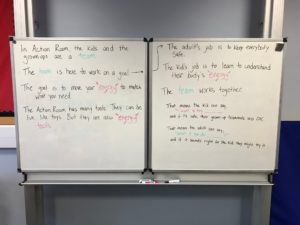One thing that’s really challenging for adults in all contexts—parenting, or professional contexts—is balancing between how much autonomy and how much protection to provide to their child.
That’s why when I was writing this reminder to go on the board in my therapy gym, for the adults who work with kids who use it to self-regulate, I knew I wanted to clearly delineate what role the adult has and what role the child has.

You can read the transcription of the whiteboards at my introduction post to this topic: What the Therapy Gym Is.
Both teammates, the adult and the child, have unique strengths in the pursuit of trying to figure out what will help the child use the energy tools to move their energy to match what is needed.
The adult might have their own life experience to draw on. The adult probably has a better understanding of different energy states, or at least more vocabulary to talk about them, and might have a better understanding of different emotions too. The adult has access to outside resources, like they might have read some ideas on an occupational therapy facebook page about what types of activities can raise or lower energy states ( 😉 ) or they might have talked to other professionals about such things before.
But the adult might also be entrenched in ideas about “the way things ought to be” or “the way things were when I was a kid” that might not be entirely accurate. The adult might have preconceived notions or biases that the child is free from. Depending on how well the adult knows the child, they might misunderstand their body cues or struggle to interpret them in the first place. AND, no matter how hard the adult tries or how good of a job they do, the adult can never be in the child’s body like the child is.
That’s why I broke it down this way. The child might be unhindered by expectations of what’s “normal” or what looks societally acceptable in a way that lets them explore something new that works for them! So if it’s not unsafe, then I don’t want the adults to say no to it just for the sake of saying no. And when the adults make suggestions, I want them to do that in a way that reinforces the child’s autonomy to think about whether or not that suggestion sounds right for them.



